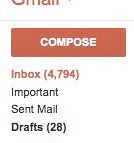
In 1999, I wrote a tongue-in-cheek blues song called The Email Blues. My purpose was to poke fun at the email madness going on at the time.
It's 13 years later and the email scene has become even weirder.
If I was going to write a sequel, it wouldn't be the blues, it would be the black and blues -- because that's how bruised most of us are feeling these days about email.
And so, as a public service, here are 14 ways to get your email act together:
1. Decide: Phone or Email:
Before sending off yet another email, ask yourself if email is really the right platform to communicate your message. Maybe a phone call would be more suitable. Or a face-to-face meeting. Or skywriting.
If your email is more than two to three paragraphs, you probably need to talk. Few people, by the way, are going to read your long emails.
If you require consensus on a matter that's emotionally charged, screw email. Try Skype or the phone or -- this just in -- talk to somebody.
.2. Create a Simple Way to Organize Your Incoming Emails:
I'm not suggesting you sign up for one more poorly facilitated webinar to figure this out, but you definitely need a better way to process all the messages flooding your inbox daily.
If you don't have a system in place, you will subject to the regrettable phenomenon of the people waiting for your long-delayed response to assume you've either moved to Mongolia or don't like them (both of which may be true).
When a new email comes in, you have five choices:
• Read it immediately and respond
• Read it and delete it
• Keep it in your inbox (which becomes your handy-dandy TO DO list)
• File it in a folder marked BIG VINNY and respond later
• File it, by subject, in folders in your sidebar
3. Read the Entire Email:
When you are pressed for time, it is unlikely you will actually read all the emails that pass before your eyes. You may glance. You may peruse. You may scan. But it's unlikely that you will really read.
The result? You will miss key nuggets of information and, without realizing it, end up confusing people down the line or waste their time because you are only partially informed about the topic, but you (madly scrolling through emails like Robin Williams on crack), think you know.
4. Write Clear Subject Lines:
Many emails get lost or neglected because their subject lines seem to have been written by Esperanto fanatics.
Cease and desist! Use laser-like, descriptive headlines.
Do not write "An Idea" in your subject heading. Write "An Idea for Tripling Our Sales: FEEDBACK NEEDED" or something that alerts the reader to what your email is really about.
5. Include "Requests for Action" When Appropriate:
If you want readers of your emails to actually respond (not just read them as if they were the backs of a cereal boxes), include the response you are requesting in the subject line, i.e.
• FEEDBACK NEEDED
• CALL ME TODAY
• SEND ME A LARGE PEPPERONI PIZZA
NOTE: If you are the one who has started an email thread and have already received all the input you need, delete the Request for Action phrase in your subject line. Otherwise, you'll get besieged by input you neither need or want.
6. Begin Your Subject Line With "FYI" if All You're Doing is Sharing Information.
• FYI: Going on Vacation
• FYI: I just won the Congressional Medal of Honor
• FYI: Cool Article About Muffins
7. Maintain Single Subject Threads: If multiple subjects are embedded in emails, readers lose track and become, functionally (or pathologically), out of the loop.
Do not add new subjects to email threads. If a given email "reminds" you of a new topic you feel a burning need to communicate, start a new email thread. Or move to Canada.
8. Use ALL CAPS Sparingly:
Caps, when used selectively, can be very effective, calling attention to key words.
Used indiscriminately, they create the impression of SHOUTING. LOTS OF SHOUTING. WHICH GETS OLD FAST. VERY FAST. LIKE THE FEW LINES YOU ARE NOW READING WHICH ARE STARTING TO FEEL LIKE AN INFOMERCIAL FOR A HOME EXERCISE MACHINE YOU CAN BUY IN SIX EASY PAYMENTS OF $99.99, BUT WILL NEVER USE.
9. Use "cc" Selectively:
Before cc'ing everyone in the known universe, pause and ask yourself: "Who really needs to read my email?" If you have doubts, ask your cc minions what email topics they really need to be cc'd on.
10. Be Wise About "To" and "Copy" Fields:
Remember this, oh multi-tracking, time-crunched, and underpaid sender of emails: Names in the "TO" field are for people you are directly speaking to. Names in the "COPY/CC" field are for people who will benefit from reading your email, but can get along very nicely without reading it.
11. Acknowledge the Sender:
If an email falls in a forest, does anyone hear it?
Please understand that it is a useful courtesy to acknowledge that you have received and understood at least some of the emails sent you way. If the email you receive cites a deadline in two weeks, don't wait two weeks to respond. Instead, send a quick "thanks" or"'will do" or "can't do" to acknowledge receipt.
If you have an objection to what the email writer is saying, speak up! Silence, in the email zone, creates nothing but ambiguity and confusion.
12. Follow the 2-Minute Rule: If it will take you less than 2 minutes to respond to an email and remove it from your inbox, do it! Do not pass GO. Do not collect $200. Do not clear-cut the rainforest.
13. Create Sacred Email Time:
Email can be incredibly distracting. If you continue checking your email throughout the day, your chances of concentrating on any one topic drop lower than the chances of health care, in America, being affordable before 2050.
Pick a few slow times of the day, instead of knee jerkily checking your inbox every 30 seconds.
14. Use the Phone More: If you need a quick answer, call. If you have something long to explain, call. If an emotional issue is on the table, call. If you need to establish rapport with someone, call.
The goal, by the way, is communication, not transmission.
Mitch Ditkoff is the President of Idea Champions and author of the very popular blog, The Heart of Innovation. HIs prediction? In 10 years, email will go the way of the BetaMax.
